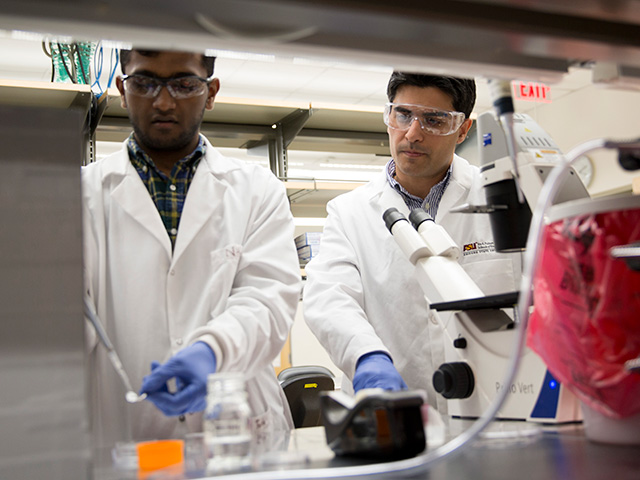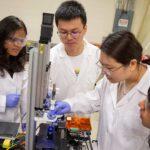
Research brings cancer cell invasion studies into 3D micro-engineered model

Above: ASU bioengineering professor Mehdi Nikkhah, at right, is developing a novel platform to study the growth, migration and interactions of breast cancer cells and the surrounding connective tissue. Photographer: Jessica Hochreiter/ASU
An Arizona State University research team is working on the micro level to shed new light on how cancer invades the body.
The research project, led by Mehdi Nikkhah, an assistant professor of bioengineering in ASU’s Ira A. Fulton Schools of Engineering, is focusing on development of a novel microscale 3D platform to study the growth, migration and interactions of breast cancer cells and the surrounding connective tissue. The research offers a precise look at how cancer cells begin to transform and invade the surrounding healthy tissues.
When a cancer cell invades the body, it responds to numerous biophysical and biochemical signals within the surrounding connective tissue or stroma – which includes an intricate extracellular matrix with blood vessels, immune cells and fibroblast cells, among others. The signals also cause various changes in biomechanical signatures of the cells. In total, these changes facilitate the migration process of the cancer cells.
Nikkhah has developed a microscale platform, to localize cancer cells and the surrounding tissue. While other research has focused on the development of similar platforms, Nikkhah’s effort is novel in the inclusion of the surrounding tissue along with a nanoscale force tomography technique – a mapping of the cells on a nanoscale giving a more complete look at how the changes occur.
The microscale environment also allows the researchers to see how the cells react under different biological conditions.
“What is not known is how these cells react in presence of stromal cells in a 3D gel,” says Nikkhah. “The tissue inside the body is 3D, not just 2D as it is typically studied. We will be also able to monitor the changes in biomechanical properties of a single cancer cell during invasion.”
The team includes ASU physics professor Robert Ros of the Center for Biological Physics who serves as the co-principal investigator on the grant.
The work could ultimately lead to advances in the understanding the invasive phenotype and biomechanical signatures of the cancer cells and provide a new platform for biological and therapeutic testing.
The research is funded by a three-year grant from the National Science Foundation.
By Gary Campbell



































